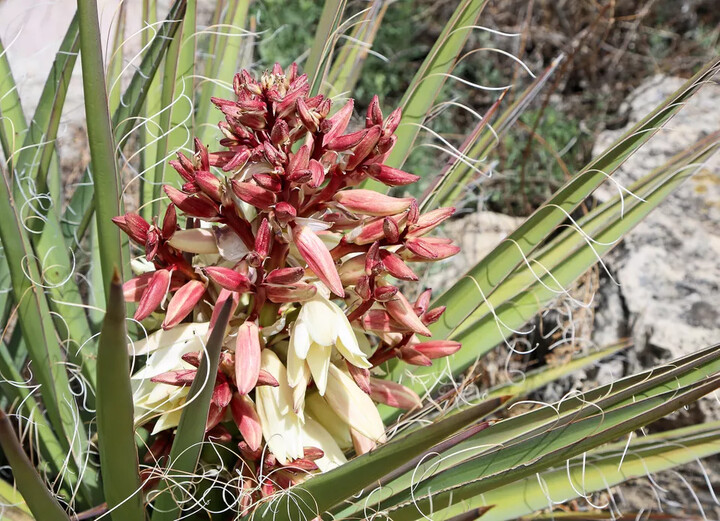
Also known as Datil yucca, blue yucca, or soapweed, the Yucca baccata (banana yucca) is a cactus-like succulent known for its fleshy, sweet seedpods that range from green to dark purple. Given the name, it's not surprising that these are the size and shape of a banana (although they taste more like sweet potatoes).
This type of yucca is native to the Southwest United States (Arizona, New Mexico, Texas, Colorado, Utah, Nevada, and the Death Valley area of California) as well as northern Mexico, and shares the same mounded clumps of stiff, sword-shaped leaves with all the other varieties of yucca. Banana yucca often grows with sagebrush, pinyon juniper, or ponderosa pine in its natural environment.
The banana yucca will grow tall spikes of creamy (sometimes purple-tinged) bell-shaped flowers that are densely arranged in the spring, but they may not grow every year, as these plants need to recuperate and rebuild a healthy store of carbohydrates before blooming again. The plants generally remain stemless but can form in large clusters. Its blue-green leaves, which are concave on top and convex underneath, create a large rosette.
Unlike many other varieties of both yucca and agave, the yucca baccata's flowers grow on a short stalk that will either remain level with the top of the plant or rise slightly above.
Along with its seedpods being consumed as food, yucca leaves also have a variety of uses, from being woven into baskets or used to make brushes, and the roots are prized as a natural soap.
Botanical Name :Yucca Baccata
Common Name :Banana Yucca
Plant Type :Cactus/Succulent
Mature Size :Foliage 2-3 feet; bloom spike 4-6 feet; clumps up to 10 feet wide
Sun Exposure :Full sun
Soil Type :Dry and sandy; well-drained
Soil pH :6.6-8.7
Bloom Time :Spring
Flower Color :Cream/White
Hardiness Zones :7-11
Native Area :Southwestern US and Mexico
Yucca Baccata Care
The yucca baccata requires very little water and practically no maintenance. It can take several years for the plant to bloom, however, and it will often die soon after its flowers fade.
These plants are probably not the best choice if you happen to have kids (or pets)--the banana yucca's leaf blades are incredibly sharp, and can even slice through the skin. They are also susceptible to spider mites, which are commonly found in dry, dusty environments. Although these can be managed with insecticidal soap spray.
Light
The banana yucca grows best in either full sun or part shade.
Water
Once they are established, the yucca baccata plant will require only occasional watering. Although these plants are drought-tolerant, they will grow best with regular irrigation. However, try to stick to one watering per week during warm weather, as you won't want to overwater. If the leaf tips begin turning brown, cut back on your watering.
Soil
Yucca varieties of all types prefer dry, sandy soil, however, they can adapt to any well-drained soil. The banana yucca will not be able to tolerate soggy conditions.
Temperature and Humidity
Although banana yucca is a desert plant that grows in the Southwestern US and Mexico, it is a surprisingly hardy succulent and can tolerate the cold.
Fertilizer
Banana yucca plants can be fertilized each spring. Just be sure to choose a balanced, slow-release fertilizer.
Potting and Repotting
Although banana yucca can be planted indoors, it will require planting several seeds because the germination process, which would typically take about three to four weeks, is a bit of a gamble with this plant.
Propagating Yucca Baccata
Yucca baccata can be divided as an offset from an established plant, or it can also be propagated by cuttings, as yucca leaves root fairly easily.
Related Varieties of Yucca
Soapweed Yucca: Southwestern variety with spikes and large white flowers
Spanish Bayonet: Produces stems of varying heights, all with sharp, rigid spikes; dense flower clusters up to two feet
Beargrass Yucca A yucca variety with softer leaves that's safe to plant around people. The beautiful, vibrant flowers produce a strong fragrance
Pruning
You can remove the banana yucca's old flower stalks before its new growth emerges in the early spring. Just be sure to protect yourself from its spiky stalks and razor-sharp leaf blades with gloves and a long-sleeved shirt.